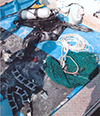Abstract
Scuba diving is a popular sports activity, even though it is associated with potential hazards. When a diver enters the water for an underwater expedition, he/she needs a series of diving gear, including a regulator, buoyancy compensator, diving suit, and weight belt, among others. Here, the author encountered a fatal diving accident wherein autopsy showed the evidence of death by drowning. The witness stated that the diver requested more weight to descend into the water, and the diver wore one more weight belt, totalling 26 kg. After a second trial of diving, he did not grab the regulator and disappeared into the water suddenly, and bubbles did not appear at the surface. Based on the witness statement and autopsy findings, the original cause of accident was concluded as an overweighted belt for descent into the water.
Figures and Tables
References
1. Edmonds D, Walker D. Scuba diving fatalities in Australia and New Zealand. Part 1. The human factor. SPUMS J. 1989; 19:94–104.
2. Lawrence C, Cooke C. Autopsy and the investigation of scuba diving fatalities. Diving Hyperb Med. 2006; 36:2–8.
3. Denoble PJ, Caruso JL, Dear GL, et al. Common causes of open-circuit recreational diving fatalities. Undersea Hyperb Med. 2008; 35:393–406.




 PDF
PDF ePub
ePub Citation
Citation Print
Print





 XML Download
XML Download